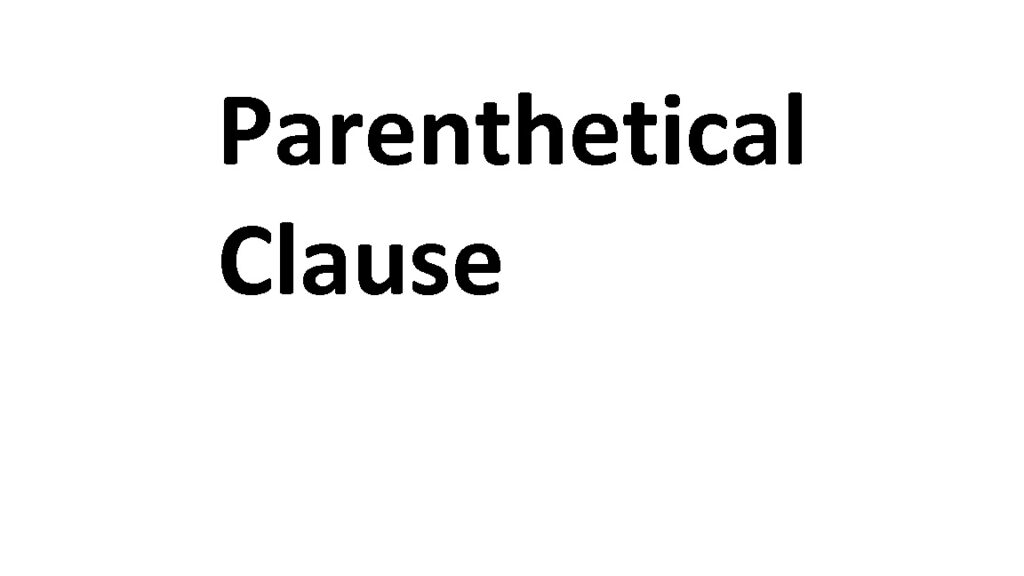A parenthetical clause, also known as a parenthetical expression or parenthetical phrase, is a clause or phrase that provides additional information within a sentence but can be removed without changing the overall meaning or grammatical structure of the sentence. It is usually set off by parentheses, commas, or dashes.
Parenthetical Clause examples
Here are some examples of parenthetical clauses in different contexts:
Parentheses:
The weather was surprisingly warm (considering it’s winter).
John’s car, a red sports car (his pride and joy), was parked in the driveway.
The team won the championship (their first in 10 years) thanks to their exceptional teamwork.
Commas:
My sister, who lives in New York, will be visiting us next week.
The movie, directed by Christopher Nolan, received critical acclaim.
The book, written in the 19th century, is still widely read today.
Dashes:
I’m looking forward to the party – assuming it doesn’t rain.
We need to finish the project by Friday – no excuses.
She finally admitted her mistake – much to everyone’s surprise.
In these examples, the parenthetical clauses provide additional information that adds context or clarifies a specific aspect of the sentence. They can contain relative clauses, participial phrases, prepositional phrases, or other types of phrases.
It’s important to note that while parenthetical clauses provide extra information, they are not essential to the main meaning of the sentence. Removing the parenthetical clause should not affect the basic structure or understanding of the sentence. However, their inclusion can enhance the reader’s understanding or provide additional details.
It’s worth mentioning that the use of parentheses, commas, or dashes to set off parenthetical clauses may vary depending on the style guide or the writer’s preference. The choice of punctuation marks should be consistent within a given piece of writing.
Parenthetical Clause purpose
Parenthetical clauses are used to provide additional information, explanations, clarifications, or examples within a sentence.
They can add descriptive details, offer alternative options, express opinions, or provide background information.
Punctuation:
Parenthetical clauses are typically set off by punctuation marks such as parentheses, commas, or dashes, depending on the writer’s preference or the style guide being followed.
Parentheses: They are used to enclose the parenthetical clause. This form of punctuation suggests a greater degree of separation from the rest of the sentence.
Commas: They are the most common way to set off a parenthetical clause. Commas provide a more moderate level of separation.
Dashes: They create a stronger break and draw more attention to the parenthetical clause.
Position:
Parenthetical clauses can appear at various positions within a sentence: at the beginning, in the middle, or at the end.
Beginning: (Considering it’s winter,) the weather was surprisingly warm.
Middle: The weather was surprisingly warm, (considering it’s winter), which was a pleasant surprise.
End: The team won the championship thanks to their exceptional teamwork (their first in 10 years).
Parenthetical clauses types:
Relative Clauses: My sister, who lives in New York, will be visiting us next week.
Participial Phrases: The book, written in the 19th century, is still widely read today.
Prepositional Phrases: I’m looking forward to the party – assuming it doesn’t rain.
Appositive Phrases: John’s car, a red sports car (his pride and joy), was parked in the driveway.
Optional removal:
Parenthetical clauses can be removed from a sentence without changing its core meaning or grammatical structure.
The sentence should still make sense and convey its main idea even after the parenthetical clause is removed. Their removal may result in some loss of additional information or context, but it should not significantly alter the overall meaning
Parenthetical clauses Stylistic considerations:
The use of parenthetical clauses should be done judiciously to avoid cluttering or overcomplicating the sentence.
They are often used for asides, as additional comments, or to provide examples that support the main idea.
It’s important to ensure that the parenthetical clause does not disrupt the flow or coherence of the sentence.
Overall, parenthetical clauses offer a way to include supplementary information within a sentence, allowing writers to provide additional context or details without disrupting the fundamental structure of the sentence. They can enhance the reader’s understanding and add depth to the writing. Length and complexity:
Parenthetical clauses can vary in length and complexity. They can range from a single word to a full sentence or even multiple sentences.
Shorter parenthetical clauses tend to be less intrusive and can be seamlessly integrated into the sentence.
Longer or more complex parenthetical clauses may require stronger punctuation, such as dashes or parentheses, to clearly separate them from the rest of the sentence.
Tone and emphasis:
Parenthetical clauses can be used to convey the writer’s tone or emphasize a particular point.
They allow for the inclusion of subjective or personal remarks, opinions, or evaluations.
For example: The movie, surprisingly, received positive reviews.
Contextual information:
Parenthetical clauses can provide crucial contextual information that helps the reader better understand the main idea of the sentence.
They can offer background details, historical references, or explanations that enrich the reader’s comprehension.
For example: The city of Paris (known as the “City of Love”) attracts millions of tourists each year.
Parenthetical clauses Stylistic variation:
While parentheses, commas, and dashes are commonly used to set off parenthetical clauses, there is some flexibility in their usage.
Different writers or style guides may have preferences for specific punctuation marks.
For example, some writers may prefer to use parentheses for parenthetical clauses that require a stronger separation, while others may opt for commas or dashes.
Sentence structure and readability:
When using parenthetical clauses, it’s important to maintain sentence structure and readability.
Long or frequent parenthetical clauses can interrupt the flow of the sentence and make it harder to follow.
Reviewing the sentence without the parenthetical clause can help ensure that the main idea remains clear and coherent.
Variations in different languages:
Parenthetical clauses exist in various languages, but their specific formatting or punctuation conventions may differ.
Some languages may use different punctuation marks or have specific grammatical structures for parenthetical clauses.
It’s always essential to consult language-specific resources or style guides when using parenthetical clauses in languages other than English.
By understanding the nuances of parenthetical clauses, their usage, and the impact they have on sentence structure and meaning, you can effectively incorporate them into your writing to provide additional information, clarify ideas, and enhance the overall readability of your text.
Ambiguity and clarity:
While parenthetical clauses can provide additional information, it’s important to ensure they do not introduce ambiguity or confusion.
Make sure the parenthetical clause is properly integrated into the sentence and does not create multiple possible interpretations.
Carefully consider the placement and wording of the parenthetical clause to maintain clarity and avoid potential misunderstandings.
Impact on sentence rhythm and pacing:
Parenthetical clauses can affect the rhythm and pacing of a sentence.
Longer and more complex parenthetical clauses can slow down the sentence, while shorter ones may have a minimal impact on the flow.
Consider the overall desired rhythm and pacing of your writing and adjust the length and placement of parenthetical clauses accordingly.
Usage in different writing styles:
The frequency and style of parenthetical clauses can vary depending on the genre or writing style.
In academic writing, parenthetical clauses are often used to provide additional references, examples, or clarifications.
In creative writing, they can be employed to convey character traits, add descriptive details, or create a specific narrative tone.
Parenthetical clauses within parenthetical clauses:
It is possible to have nested parenthetical clauses within a sentence.
In such cases, it’s crucial to use clear punctuation and formatting to avoid confusion.
For example: The city (known as the “City of Love” to tourists) (and also famous for its cuisine) attracts millions of visitors each year.
Overuse and redundancy:
While parenthetical clauses can be useful, it’s important not to overuse them.
Too many parenthetical clauses in a single sentence or paragraph can make the writing cumbersome and difficult to follow.
Evaluate whether the information provided by the parenthetical clause is truly necessary or if it can be conveyed in a more concise manner.
Introducing contrasting or contradictory information:
Parenthetical clauses can be used to introduce contrasting or contradictory information within a sentence.
They allow for the inclusion of an opposing viewpoint or a different perspective on the main idea.
For example: The results of the study were inconclusive (contrary to what was expected).
By considering these additional points, you can further refine your use of parenthetical clauses and make informed decisions about when and how to incorporate them into your writing. Remember to maintain clarity, readability, and coherence in your sentences while utilizing parenthetical clauses effectively.
Find us on Facebook
Practice more Digital SAT

